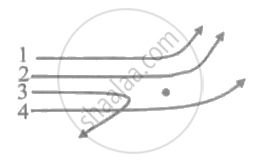Advertisements
Advertisements
प्रश्न
What is the difference between a nuclear reactor and a nuclear bomb?
उत्तर
- Nuclear Reactor
A nuclear reactor is a machine where electricity and heat energy is generated by utilizing the power of atoms. In this mechanism, nuclear chain reactions are produced, controlled, and contained releasing a tremendous amount of energy. This controlled energy is used in electricity generation and radioactive isotopes production. These isotopes are used in the treatment and research of cancer in the medical field. All operating nuclear reactors are “critical.” When reactors are running at a constant power level, they are said to be in a “critical condition.”
These reactors use heavy atoms as fuel instead of fossil fuels. Fast-moving electrons strike a radioactive nucleus such as Plutonium-239 or Uranium-235 causing the nucleus to split. This splitting process is known as fission. In the process of fission, a tremendous amount of energy, radiation, and free electrons are released. These free electrons that are released are guided to strike other nuclei and so on causing a chain reaction.
Neutron moderators and neutron poisons control these fast-moving electrons and slow them down while becoming absorbed in other nuclei, thus managing the output of electricity from a reactor. The moderators are heavy water, water, and solid graphite.
- Nuclear Bomb
In a nuclear bomb, there is a nuclear device having massive destructive power coming from uncontrolled fusion and fission reactions. The fusion and fission processes generate a tremendous amount of energy with a small amount of matter. This matter is usually the unstable nuclei of Plutonium-239 and Uranium-235. An atom bomb is categorized as a fission bomb and a hydrogen bomb as a fusion bomb are both weapons of mass destruction. In World War II, Hiroshima and Nagasaki are recent examples of such mass destruction. In fusion bombs, nuclear fusion is the result of a huge amount of released energy while in the case of fission bombs the released energy is the result of fission reactions.
संबंधित प्रश्न
The half-life of \[\ce{_38^90Sr}\] is 28 years. Determine the disintegration rate of its 5 mg sample.
Determine the maximum angular speed of an electron moving in a stable orbit around the nucleus of the hydrogen atom.
The mass of the earth is 81 times the mass of the moon and the distance between their centres is R. The distance from the centre of the earth, where gravitational force will be zero is ______.
The diagram shows the path of four `alpha` - particles of the same energy being scattered by the nucleus of an atom simultaneously. Which of these are/is not physically possible?

Two protons are kept at a separation of 10 nm. Let Fn and Fe be the nuclear force and the electromagnetic force between them ____________.
The radius of germanium (Ge) nuclide is measured to be twice the radius of `""^9""_4"Be"`. The number of nucleons in Ge will be ____________.
If radius of the `{:(27),(13):}` Al nucleus is taken to be RAI then the radius of `{:(125), (53):}` Te nucleus is ____________.
A sample of radioactive element contains 8 × 1016 active nuclei. The half-life of the element is 15 days. The number of nuclei decayed after 60 days is ______.
Explain how nuclear size of an atom is estimated.
Define the term Nucleons.
